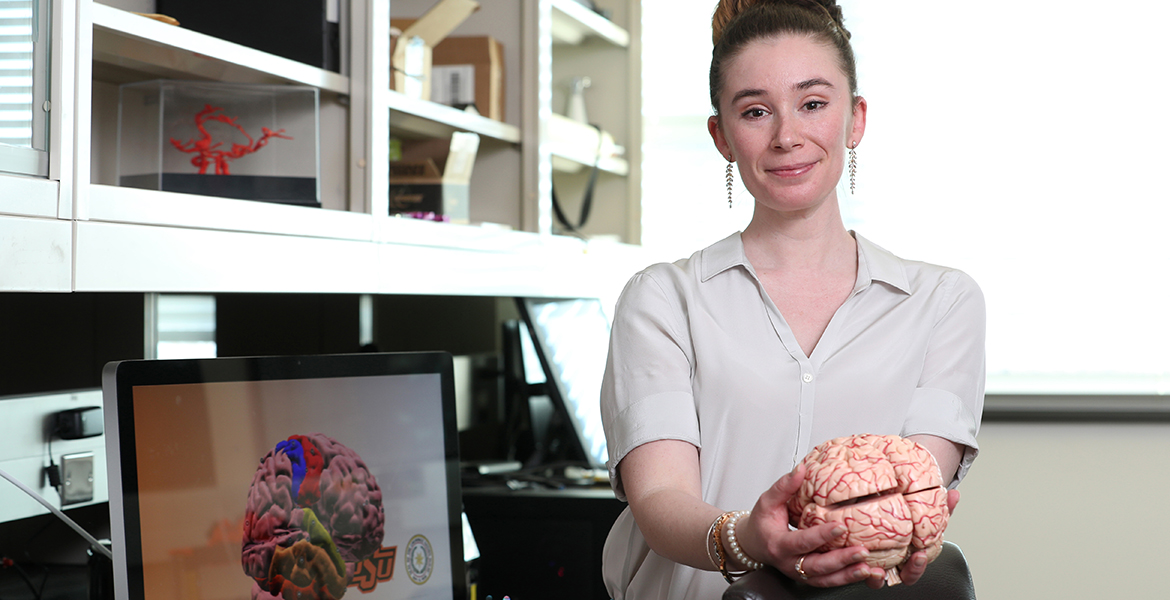
OSU-CHS neuroanatomy faculty earns national recognition
Wednesday, March 17, 2021
In the five years she has been at OSU Center for Health Sciences, Haley O’Brien, Ph.D., has helped reformat the medical nervous system curriculum, developed the first Course Director’s Handbook and won OSU’s App Competition for the development of a clinical neuroanatomy educational app with a group of medical students.
O’Brien, an assistant professor of anatomy and cell biology, has also mentored nine Ph.D. and master’s students and 15 medical students. Because of her hard work and dedication, she has recently been recognized with the Basmajian Award from the American Association of Anatomy.
The Basmajian Award recognizes health science faculty who are in the early stages of their careers teaching human or veterinary gross anatomy; have documented excellence in their contribution to teaching; and have outstanding accomplishments in biomedical research or scholarship in education.
O’Brien said she was nominated by a former student Leigha Lynch, Ph.D., who graduated with a doctorate from OSU-CHS School of Biomedical Sciences in 2018 and is now an assistant professor of anatomy at Midwestern University’s College of Osteopathic Medicine.
“I’m an ugly crier,” O’Brien said of when she learned she had earned the award. “It’s really touching. For a long time, I’ve worked hard to make my research and teaching as accessible as possible.”
"The goal is to make people care about something they’re scared about — neuroanatomy."
A big part of making the subject more accessible was reviewing and reformatting the OSU-CHS neuroanatomy curriculum. Prior to coming to OSU, O’Brien taught several courses including neuroanatomy at Ohio University Heritage College of Osteopathic Medicine.
“We taught two different curricula. One was self-guided and the students came together with their professors to learn, and then a more traditional curriculum where everything is broken down into systems,” she said. “I saw what it was like to be in a classroom for 30 hours a week.”
When it came time to review OSU-CHS neuroanatomy curriculum, O’Brien said she kept thinking back to her previous experience working with students who were just trying to stay on top of their classes.
“I reviewed our neuro curriculum, and it was a lot. And sometimes less can be more,” she said, so she recommended a combination of traditional lecture and a lab where students do clinical exercises for more hands-on experience. “We can connect those two types together and to what students really care about.”
The reformatted curriculum may have reduced the overall content, but it increased the problem-solving skills resulting in an average student improvement of a full letter grade.
Another way O’Brien is working to help students understand neuroanatomy and the nervous system is through the neuro relay app she helped develop along with a team of medical students who were looking for a more in-depth and three-dimensional way to look at neuro systems and disease.
“Students come in so worried about the nervous system, they’ve heard it’s really hard. There’s this cultural roadblock to learning the nervous system. It even has a name, neurophobia,” she said. “If we (instructors) don’t express that we are here to work with them, if we don’t work to assuage those fears, it’s hard for students to focus on the content.”
The app, which is still in the development stage, was a response to students who wanted a different way to look at neuro pathways and a tool to better diagnose neuro conditions based on symptoms.
“All of the features were ideas our medical students requested. I don’t think the app proposal would have been as strong without the students. They’re really great and have great ideas,” she said.
When faculty are open and available to students and their concerns and administration are supportive and student-focused, it makes the whole experience better for everyone, O’Brien said.
“I feel like I’ve accomplished a lot by having great people around me. We have a really good neuro team here. Especially with Dr. Kenneth Miller and Dr. Dolores Vazquez Sanroman, we all play to each other’s strengths,” she said. “We try to build this community of positivity. We try to be kind, compassionate and understanding.”
MEDIA CONTACT: Sara Plummer | Communications Coordinator | 918-561-1282 | sara.plummer@okstate.edu
